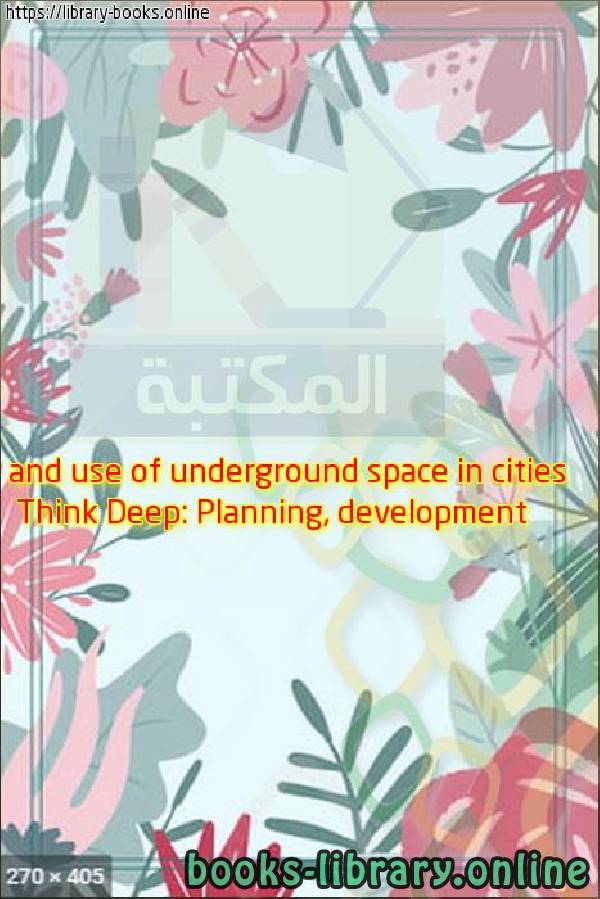📘 قراءة كتاب Think Deep: Planning, development and use of underground space in cities أونلاين


Think Deep: Planning, development and use
of underground space in cities
Think Deep: Planning, development
and use of underground space in cities
Copyright 2015 © International Society
of City and Regional Planners and
International Tunnelling and
Underground Space Association.
All rights reserved.
This publication is part of the ongoing
co-operation between ISOCARP and ITA/
ITACUS. This project was managed by
ISOCARP and financed by ITA.
All contributors are members of ISOCARP.
No part of this publication may be
reproduced, stored in a retrieval system or
transmitted in any form or by any means
electronic, mechanical, photocopying,
recording or otherwise, without the prior
written permission of the Publisher.
Authorship Responsibility: the original
author is responsible for the content
of the manuscript.
Editors
Han Admiraal
, ITACUS
Shipra Narang Suri
, ISOCARP
Coordinator
Gaby Kurth
, ISOCARP
Designer
Ricardo Moura, Portugal
www.ricardomoura.pt
ISBN 978-94-90354-34-3
Cover:
Naples underground cavities map
Copyright 2015 © Vincenzo De Stefano,
Valerio Di Pinto, Carlo Gerundo
Printed in the Netherlands
by Drukkerij Aktief, Pijnacker
Foreword
Shipra Narang Suri, ISoCArP Vice President
Han Admiraal, ITACUS Chair
PlANNINg F
or UNdergroUNd
SPACeS “NY-loN” UNdergroUNd
elizabeth r
eynolds
Paul r
eynold
NAPleS ANd ITS PArAllel CITY
Vincenzo de Stefano
Valerio di Pinto
Carlo gerundo
NeTworkINg UNdergroUNd
ArCHAeologICAl ANd CUl
TUrAl SITeS:
THe CASe oF THe A
THeNS MeTro
Marilena Papageorgiou
UNdergroUNd ANd CAVerN SPACe
deVeloPMeNT IN HoNg k
oNg
liang Huew w
ANg
THe UTIlIzATIoN oF UNdergroUNd
SPACe PlANNINg IN TIANjIN (CHINA)
CeNTrAl CITY (2013-2020)
Shi w
ujun
Xiao Yu
gong Yuan
zhao guang
ISOCARP ·
ThInk DeeP
: PlAnnIng, Devel
OP
menT
AnD
uSe Of unDeR
gROunD
SPACe In CITIeS
4
5
FORE
wORD
conclusions. The fifth case study looks into how underground
space planning has been utilised in the Chinese city of Tianjin.
Five case studies undertaken by planners, urban designers and
architects. Five case studies that intend to show the richness of
underground space. Five case studies that start to give some in-
sights into the possibilities but also the impediments of under
-
ground space use. If all the case studies illustrate one point, it is
that the use of urban underground space is very much situational
and often restricted not just by geology or underground ecology,
but equally by legislation that never considered the possibility
of large-scale subsurface development and use. One overriding
consideration seems to surface from all case studies, and that
is the need to plan.
without a vision on the use of urban under
-
ground space, without planning and without a strategy for man-
aging the use of this vast spatial asset, all developments will be
based on ‘first come, first served’. This will lead to spatial conges-
tion and competition between resources. Many cities are already
developing large energy schemes by driving vertical pipes into
the underground.
whether these are making future horizontal
alignments of transport solutions impossible, just for example, is
often not even being considered.
A contemporary of Hénard was George
webster, Chief Engineer
and Surveyor of Philadelphia, USA who in 1914 wrote about the
necessity to plan the layout of what he called “the subterranean
street”
2
. webster was concerned with the placement of utilities
in the subsurface and chaos arising if not planned. But his vision
went further, like Hénard he saw a future for underground space.
Hénard and
webster were followed by French architect Édouard
Utudjian who famously wrote
3
: ‘
It is necessary that the urban plan-
ner thinks deep and that underground development of cities is done
not through random necessities, but according to a definite commit-
ment, legislation and a predetermined plan.
’
This joint publication by ISOCARP and ITACUS hopes to stimu-
late some innovative thinking on the use of underground space.
we urge planning practitioners not only to consider the possibili-
ties, but also to think deep and to make underground space part
of the planning of our future cities. In doing so, we reaffirm that
the time has come for new planning paradigms as we are transi-
tioning to a new era in which our cities will continue to play an
evermore important role for people; cities of the future, which are
resilient, inclusive and above all liveable.
Shipra Narang Suri,
ISOCARP Vice President
Han Admiraal,
ITACUS Chair
حجم الكتاب عند التحميل : 7.7 ميجا بايت .
نوع الكتاب : pdf.
عداد القراءة:
اذا اعجبك الكتاب فضلاً اضغط على أعجبني و يمكنك تحميله من هنا:

شكرًا لمساهمتكم
شكراً لمساهمتكم معنا في الإرتقاء بمستوى المكتبة ، يمكنكم االتبليغ عن اخطاء او سوء اختيار للكتب وتصنيفها ومحتواها ، أو كتاب يُمنع نشره ، او محمي بحقوق طبع ونشر ، فضلاً قم بالتبليغ عن الكتاب المُخالف:
 قبل تحميل الكتاب ..
قبل تحميل الكتاب ..
يجب ان يتوفر لديكم برنامج تشغيل وقراءة ملفات pdf
يمكن تحميلة من هنا 'http://get.adobe.com/reader/'


 منصّة المكتبة
منصّة المكتبة